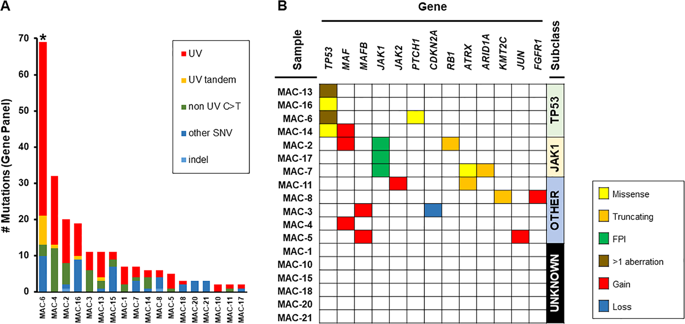当前位置:
X-MOL 学术
›
Modern Pathol.
›
论文详情
Our official English website, www.x-mol.net, welcomes your feedback! (Note: you will need to create a separate account there.)
Next-generation sequencing implicates oncogenic roles for p53 and JAK/STAT signaling in microcystic adnexal carcinomas.
Modern Pathology ( IF 7.5 ) Pub Date : 2019-12-19 , DOI: 10.1038/s41379-019-0424-4 May P Chan 1, 2, 3 , Komal R Plouffe 1, 4, 5 , Chia-Jen Liu 1, 4 , Nallasivam Palanisamy 6 , Shannon Carskadon 6 , Lili Zhao 7 , Rosalynn M Nazarian 8 , Alison B Durham 2, 3 , Timothy M Johnson 2, 3 , Aleodor A Andea 1, 2, 3 , Rajiv M Patel 1, 2, 3 , Lori Lowe 1, 2, 3 , Douglas R Fullen 1, 2, 3 , Noah A Brown 1 , Scott A Tomlins 1, 3, 4, 5 , Aaron M Udager 1, 4 , Paul W Harms 1, 2, 3, 4
Modern Pathology ( IF 7.5 ) Pub Date : 2019-12-19 , DOI: 10.1038/s41379-019-0424-4 May P Chan 1, 2, 3 , Komal R Plouffe 1, 4, 5 , Chia-Jen Liu 1, 4 , Nallasivam Palanisamy 6 , Shannon Carskadon 6 , Lili Zhao 7 , Rosalynn M Nazarian 8 , Alison B Durham 2, 3 , Timothy M Johnson 2, 3 , Aleodor A Andea 1, 2, 3 , Rajiv M Patel 1, 2, 3 , Lori Lowe 1, 2, 3 , Douglas R Fullen 1, 2, 3 , Noah A Brown 1 , Scott A Tomlins 1, 3, 4, 5 , Aaron M Udager 1, 4 , Paul W Harms 1, 2, 3, 4
Affiliation

|
Microcystic adnexal carcinoma is a locally aggressive sweat gland carcinoma characterized by its infiltrative growth and histopathologic overlap with benign adnexal tumors, often posing challenges to both diagnosis and management. Understanding the molecular underpinnings of microcystic adnexal carcinoma may allow for more accurate diagnosis and identify potential targetable oncogenic drivers. We characterized 18 microcystic adnexal carcinomas by targeted, multiplexed PCR-based DNA next-generation sequencing of the coding sequence of over 400 cancer-relevant genes. The majority of cases had relatively few (<8) prioritized somatic mutations, and lacked an ultraviolet (UV) signature. The most recurrent mutation was TP53 inactivation in four (22%) tumors. Frame-preserving insertions affecting the kinase domain of JAK1 were detected in three (17%) cases, and were nonoverlapping with TP53 mutations. Seven (39%) cases demonstrated copy number gain of at least one oncogene. By immunohistochemistry, p53 expression was significantly higher in microcystic adnexal carcinomas with TP53 mutations compared with those without such mutations and syringomas. Similarly, phospho-STAT3 expression was significantly higher in microcystic adnexal carcinomas harboring JAK1 kinase insertions compared with those with wild-type JAK1 and syringomas. In conclusion, microcystic adnexal carcinomas are molecularly heterogeneous tumors, with inactivated p53 or activated JAK/STAT signaling in a subset. Unlike most other nonmelanoma skin cancers involving sun-exposed areas, most microcystic adnexal carcinomas lack evidence of UV damage, and hence likely originate from a relatively photo-protected progenitor population in the dermis. These findings have implications for the biology, diagnosis, and treatment of microcystic adnexal carcinomas, including potential for therapeutic targeting of p53 or the JAK/STAT pathway in advanced tumors.
中文翻译:

下一代测序涉及 p53 和 JAK/STAT 信号在微囊性附件癌中的致癌作用。
微囊性附件癌是一种局部侵袭性汗腺癌,其特点是浸润性生长,组织病理学与良性附件肿瘤重叠,常给诊断和治疗带来挑战。了解微囊性附件癌的分子基础可能有助于更准确的诊断并确定潜在的可靶向致癌驱动因素。我们通过对 400 多个癌症相关基因的编码序列进行靶向、基于多重 PCR 的 DNA 下一代测序来表征 18 例微囊性附件癌。大多数病例的优先级体细胞突变相对较少 (<8),并且缺乏紫外线 (UV) 特征。最常见的突变是四个 (22%) 肿瘤中的 TP53 失活。在三个 (17%) 病例中检测到影响 JAK1 激酶结构域的保框插入,并且与 TP53 突变不重叠。七 (39%) 例显示至少一种致癌基因的拷贝数增加。通过免疫组织化学,与没有这种突变和汗管瘤的微囊性附件癌相比,p53 表达在具有 TP53 突变的微囊性附件癌中显着更高。类似地,与野生型 JAK1 和汗管瘤相比,磷酸化 STAT3 表达在携带 JAK1 激酶插入的微囊性附件癌中显着更高。总之,微囊性附件癌是分子异质性肿瘤,其中一部分具有失活的 p53 或激活的 JAK/STAT 信号。与涉及阳光照射区域的大多数其他非黑色素瘤皮肤癌不同,大多数微囊性附件癌缺乏紫外线损伤的证据,因此可能起源于真皮中相对受光保护的祖细胞群。这些发现对微囊性附件癌的生物学、诊断和治疗具有重要意义,包括在晚期肿瘤中靶向 p53 或 JAK/STAT 通路的治疗潜力。
更新日期:2019-12-20
中文翻译:

下一代测序涉及 p53 和 JAK/STAT 信号在微囊性附件癌中的致癌作用。
微囊性附件癌是一种局部侵袭性汗腺癌,其特点是浸润性生长,组织病理学与良性附件肿瘤重叠,常给诊断和治疗带来挑战。了解微囊性附件癌的分子基础可能有助于更准确的诊断并确定潜在的可靶向致癌驱动因素。我们通过对 400 多个癌症相关基因的编码序列进行靶向、基于多重 PCR 的 DNA 下一代测序来表征 18 例微囊性附件癌。大多数病例的优先级体细胞突变相对较少 (<8),并且缺乏紫外线 (UV) 特征。最常见的突变是四个 (22%) 肿瘤中的 TP53 失活。在三个 (17%) 病例中检测到影响 JAK1 激酶结构域的保框插入,并且与 TP53 突变不重叠。七 (39%) 例显示至少一种致癌基因的拷贝数增加。通过免疫组织化学,与没有这种突变和汗管瘤的微囊性附件癌相比,p53 表达在具有 TP53 突变的微囊性附件癌中显着更高。类似地,与野生型 JAK1 和汗管瘤相比,磷酸化 STAT3 表达在携带 JAK1 激酶插入的微囊性附件癌中显着更高。总之,微囊性附件癌是分子异质性肿瘤,其中一部分具有失活的 p53 或激活的 JAK/STAT 信号。与涉及阳光照射区域的大多数其他非黑色素瘤皮肤癌不同,大多数微囊性附件癌缺乏紫外线损伤的证据,因此可能起源于真皮中相对受光保护的祖细胞群。这些发现对微囊性附件癌的生物学、诊断和治疗具有重要意义,包括在晚期肿瘤中靶向 p53 或 JAK/STAT 通路的治疗潜力。



























 京公网安备 11010802027423号
京公网安备 11010802027423号